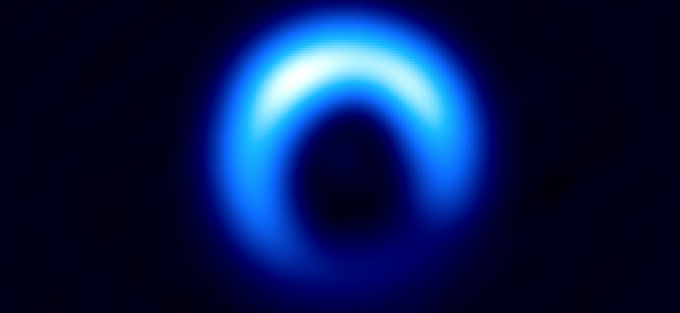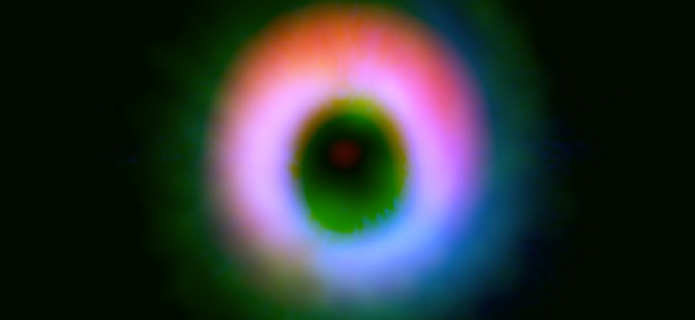ALMA measures size of planets’ seeds
5 December, 2016 / Read time: 6 minutes
Scientific Paper ALMA Kids PublicationResearchers using the Atacama Large Millimeter/submillimeter Array (ALMA), have for the first time, achieved a precise size measurement of small dust particles around a young star through radio-wave polarization. ALMA’s high sensitivity for detecting polarized radio waves made possible this important step in tracing the formation of planets around young stars.
Astronomers have believed that planets are formed from gas and dust particles, although the details of the process have been veiled. One of the major enigmas is how dust particles as small as 1 micrometer aggregate to form a rocky planet with a diameter of 10 thousand kilometers. Difficulty in measuring the size of dust particles has prevented astronomers from tracing the process of dust growth.
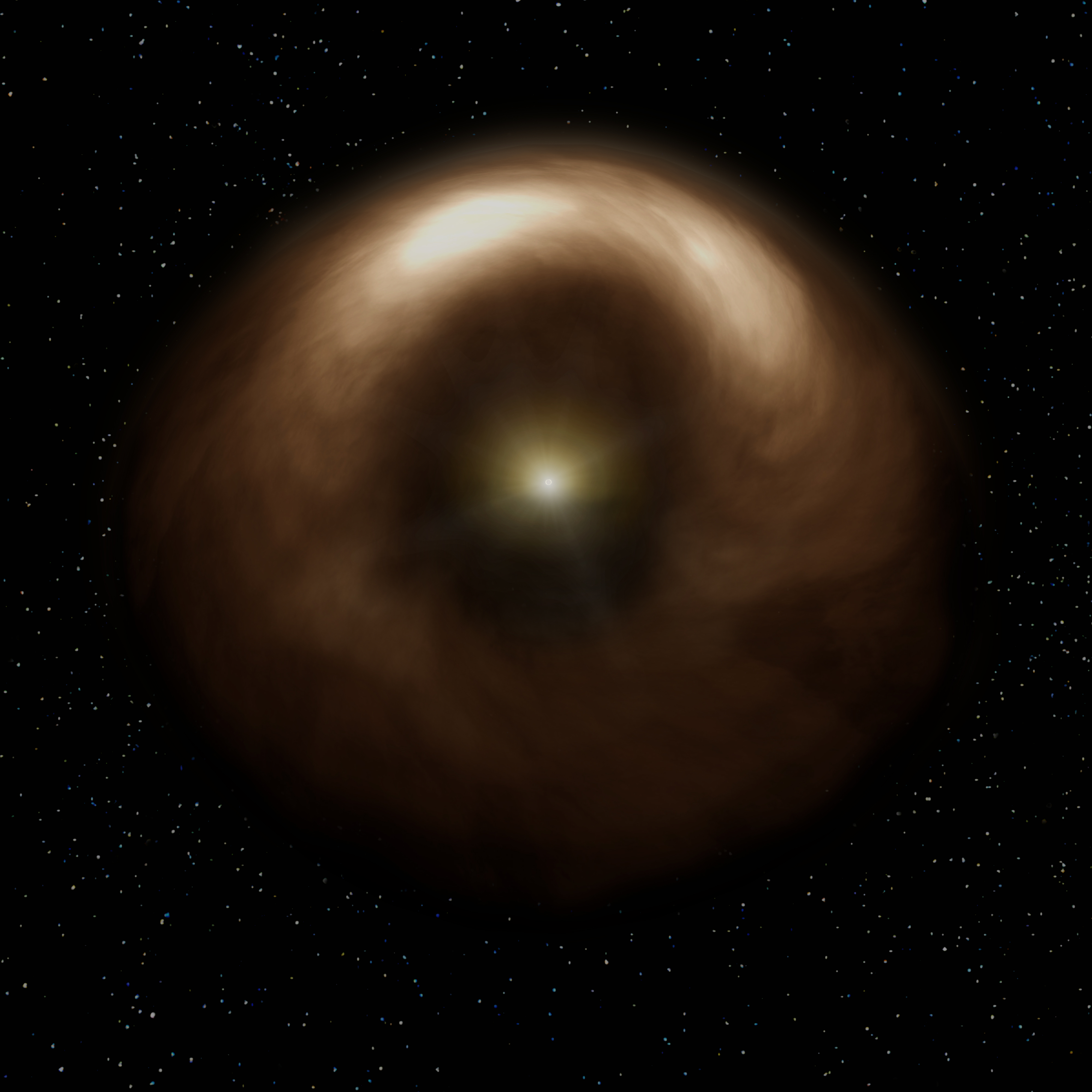
Artist’s impression of a dust ring around the young star HD 142527. Dust around the star has an asymmetric distribution. Credit: NAOJ | Download image
Akimasa Kataoka, a Humboldt Research Fellow stationed at Heidelberg University and the National Astronomical Observatory of Japan (NAOJ), tackled this problem. He and his collaborators have theoretically predicted that, around a young star, radio waves scattered by the dust particles should carry unique polarization features. He also noticed that the intensity of polarized emissions allows us to estimate the size of dust particles far better than other methods.
To test their prediction, the team led by Kataoka observed the young star HD 142527 with ALMA1 and discovered, for the first time, the unique polarization pattern in the dust disk around the star. As predicted, the polarization has a radial direction in most parts of the disk, but at the edge of the disk, the direction is flipped perpendicular to the radial direction.
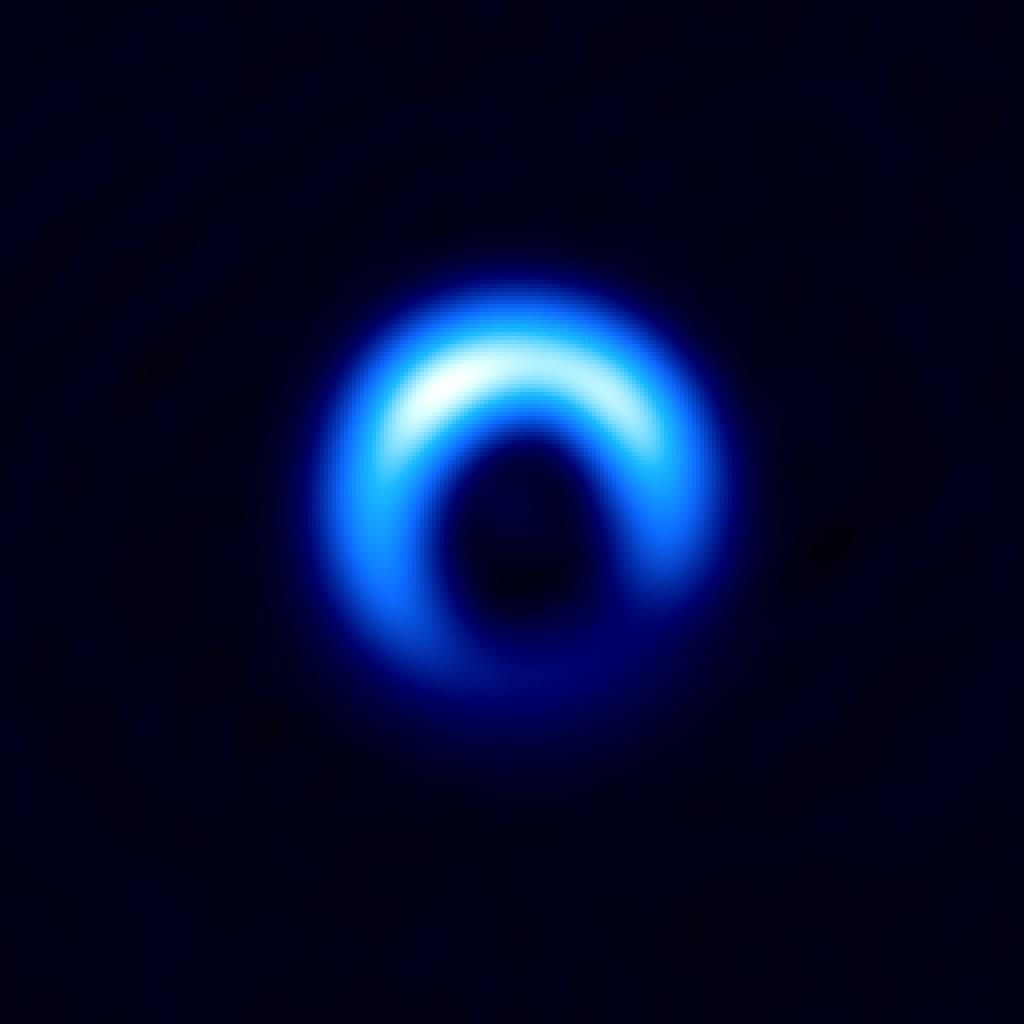
Dust disk around the young star HD 142527 observed with ALMA. Credit: ALMA (ESO/NAOJ/NRAO), Kataoka et al. | Download image
Comparing the observed intensity of the polarized emissions with the theoretical prediction, they determined that the size of the dust particles is at most 150 micrometers. This is the first estimation of the dust size based on polarization. Surprisingly, this estimated size is more than 10 times smaller than previously thought.
“In the previous studies, astronomers have estimated the size based on radio emissions assuming hypothetical spherical dust particles,” explains Kataoka. “In our study, we observed the scattered radio waves through polarization, which carries independent information from the thermal dust emission. Such a big difference in the estimated size of dust particles implies that the previous assumption might be wrong.”
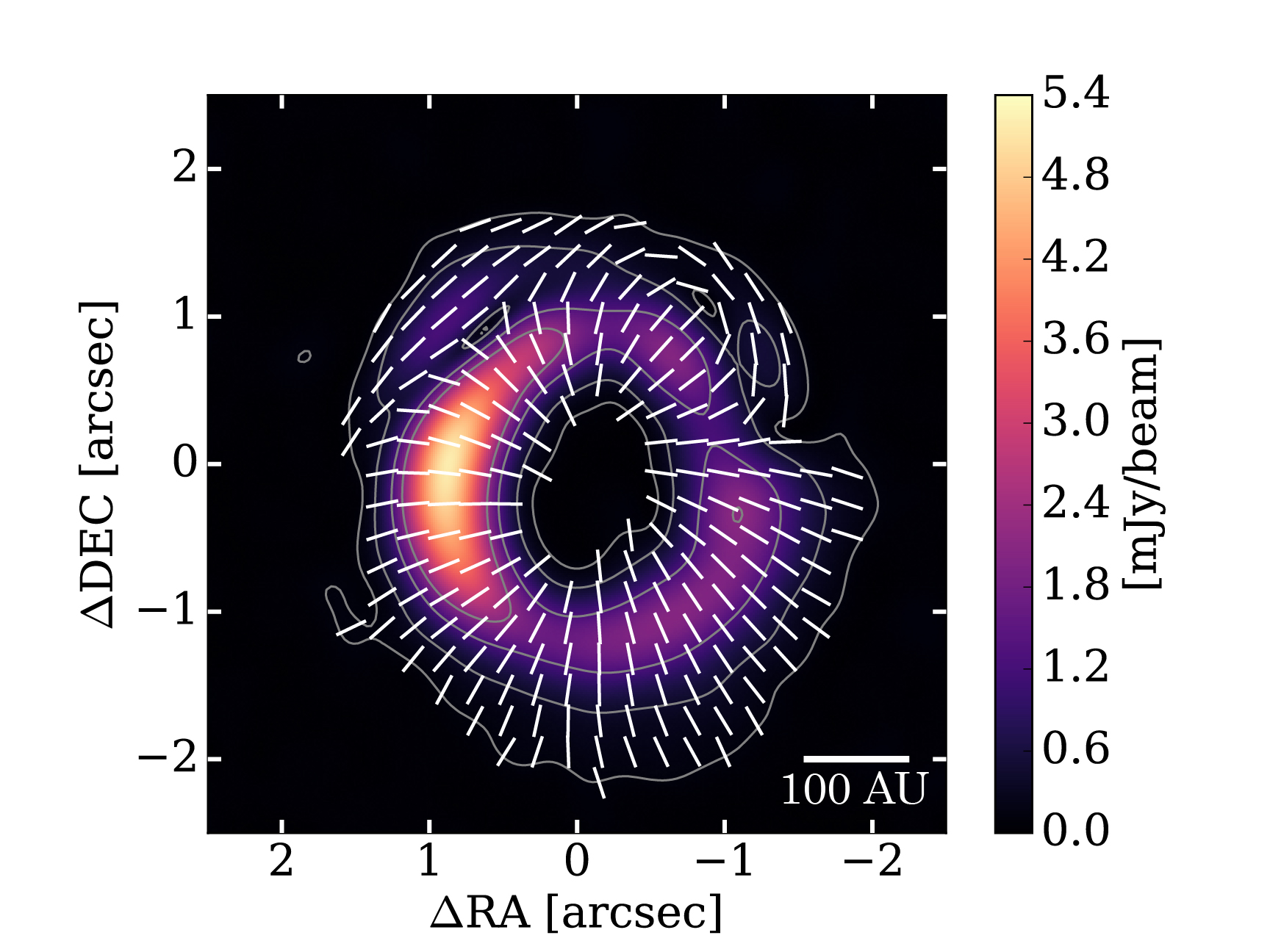
Polarization pattern obtained by ALMA around the young star HD 142527. Contours show the total intensity of dust emissions and the color image shows the intensity of polarized emissions. White bars show the direction of polarization. Credit: ALMA (ESO/NAOJ/NRAO), Kataoka et al. | Download image
The team’s idea to solve this inconsistency is to consider fluffy, complex-shaped dust particles, not simple spherical dust2. In the macroscopic view, such particles are indeed large, but in the microscopic view, each small part of a large dust particle scatters radio waves and produces unique polarization features. Per the present study, astronomers obtain these “microscopic” features through polarization observations. This idea might prompt astronomers to reconsider the previous interpretation of observational data.
“The polarization fraction of radio waves from the dust disk around HD 142527 is only a few percent. Thanks to ALMA’s high sensitivity, we have detected such a tiny signal to derive information about the size and shape of the dust particles,” said Kataoka. “This is the very first step in the research on dust evolution with polarimetry, and I believe the future progress will be full of excitement.”
Additional information
These observation results were published as Kataoka et al. “Millimeter Polarization Observation of the Protoplanetary Disk around HD 142527” in the Astrophysical Journal Letters in November 2016.
The research team members are:
Akimasa Kataoka (Humboldt Research Fellowship for Postdoctoral Researchers / Heidelberg University / National Astronomical Observatory of Japan / former Postdoctral Fellowship for Research Abroad at Japan Society for Promoting Science), Takashi Tsukagoshi (Ibaraki University), Munetake Momose (Ibaraki University), Hiroshi Nagai (National Astronomical Observatory of Japan), Takayuki Muto (Kogakuin University), Cornelis P. Dullemond (Heidelberg University), Adriana Pohl (Heidelberg University / Max Planck Institute for Astronomy), Misato Fukagawa (Nagoya University), Hiroshi Shibai (Osaka University), Tomoyuki Hanawa (Chiba University), Koji Murakawa (Osaka Sangyo University)
This research was supported by a Grant-in-Aid from the Japan Society for the Promotion of Science and the Ministry of Education, Culture, Sports, Science and Technology, Japan (No. 23103004、15K17606、26800106).
The Atacama Large Millimeter/submillimeter Array (ALMA), an international astronomy facility, is a partnership of the European Organisation for Astronomical Research in the Southern Hemisphere (ESO), the U.S. National Science Foundation (NSF) and the National Institutes of Natural Sciences (NINS) of Japan in cooperation with the Republic of Chile. ALMA is funded by ESO on behalf of its Member States, by NSF in cooperation with the National Research Council of Canada (NRC) and the Ministry of Science and Technology (MOST) in Taiwan and by NINS in cooperation with the Academia Sinica (AS) in Taiwan and the Korea Astronomy and Space Science Institute (KASI).
ALMA construction and operations are led by ESO on behalf of its Member States; by the National Radio Astronomy Observatory (NRAO), managed by Associated Universities, Inc. (AUI), on behalf of North America; and by the National Astronomical Observatory of Japan (NAOJ) on behalf of East Asia. The Joint ALMA Observatory (JAO) provides the unified leadership and management of the construction, commissioning and operation of ALMA.
- HD 142527 is located 500 light-years away from the Earth, in the direction of the constellation Lupus, the Wolf. The age of the star is estimated to be 5 million years old and its mass twice that of the Sun. HD 142527 is a popular target among astronomers to study planet formation and several findings about it have previously been reported from ALMA (for example, “ALMA Discovers a Formation Site of a Giant Planetary System”) and the Subaru Telescope (for example, “Diversity the Norm in Protoplanetary Disks: Astronomers Find Donuts, Spirals and Now Banana Splits”) ↩
- Prior to the ALMA observations, Kataoka had propounded fluffy dust particles around young stars. Such particles are not only favored to explain ALMA’s observational results, but also help overcome other big problems in the dust aggregation process. For details, see the press release “The seeds of planets are fluffy” issued in 2013. ↩
Contacts
-
Nicolás Lira
Education and Public Outreach Coordinator
Joint ALMA Observatory, Santiago - Chile
Phone: +56 2 2467 6519
Cel: +56 9 9445 7726
Email: [email protected]
-
Masaaki Hiramatsu
Education and Public Outreach Officer, NAOJ Chile
Observatory, Tokyo - Japan
Phone: +81 422 34 3630
Email: [email protected]
-
Richard Hook
Public Information Officer, ESO
Garching bei München, Germany
Phone: +49 89 3200 6655
Cel: +49 151 1537 3591
Email: [email protected]
-
Charles E. Blue
Public Information Officer
National Radio Astronomy Observatory Charlottesville, Virginia - USA
Phone: +1 434 296 0314
Cel: +1 202 236 6324
Email: [email protected]
